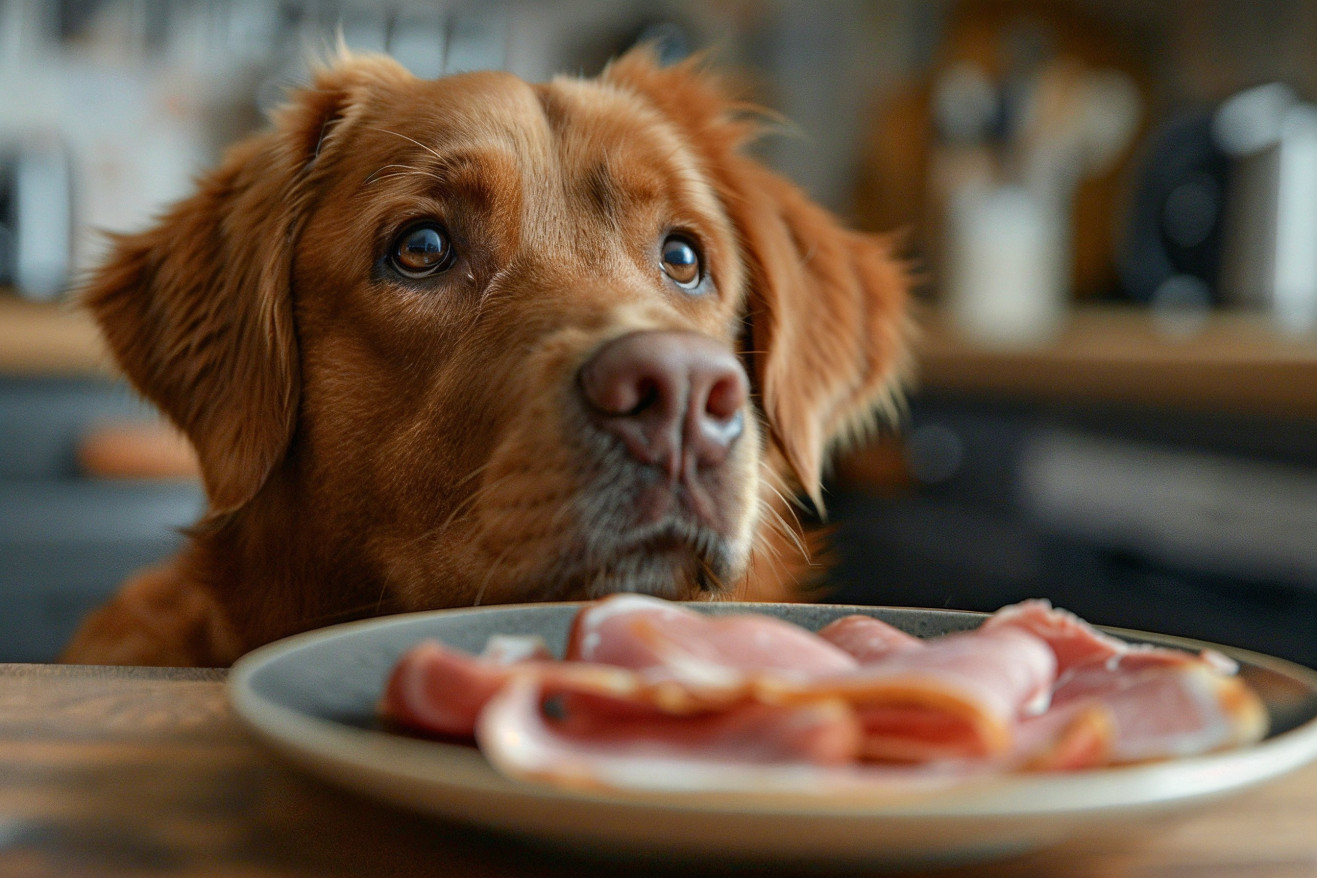My Dog Ate Ham: What to Know and How to Avoid It
27 April 2024 • Updated 25 April 2024

Has your furry friend found their way to some ham? Here's what to do if your dog has eaten this salty, cured meat. While not ideal, a small amount of ham is usually not an emergency for dogs. If they only ate a little, monitor for signs of gastrointestinal upset like vomiting or diarrhea. However, large amounts pose risks like salt toxicity or pancreatitis, so contact your vet right away.
This article will explore expert opinions and research to offer insights into how to deal with this situation. It will discuss how to avoid it, what to do if it happens, and when you should seek professional help. By the end, you'll feel confident that you can protect your dog from the dangers of eating ham.
Is it safe for my dog to eat ham?
Risks of Ham for Dogs
Even though a small piece of ham may not seem like a big deal, the truth is that this salty, cured meat can be very dangerous for our furry friends. In fact, ham is so high in sodium and fat that it can cause vomiting, diarrhea, dehydration, and even kidney damage in dogs, MetLife Pet Insurance reports. The fat content also makes it more likely that dogs will develop pancreatitis, which can be life-threatening.
In addition, ham bones are extremely risky. According to Petco, these bones can splinter and cause internal injuries, blockages, or perforations in the digestive tract. Even small amounts of ham should be consumed in moderation, as it often contains nitrates, which are preservatives that can be toxic to dogs, according to the Merck Veterinary Manual.
Although eating a little bit of ham every now and then may not cause any immediate problems for your dog, Pumpkin® points out that eating ham on a regular basis can lead to obesity, pancreatitis, and even sodium ion poisoning. As a result, all veterinarians agree that ham should not be given to dogs as a regular treat.
What to Do if Your Dog Eats a Large Amount of Ham
If your dog has eaten a large amount of ham, it's important to call your vet right away. JustAnswer explains that the biggest risk is pancreatitis because of the high fat content. Your vet may suggest that you induce vomiting at home using 2 tablespoons of 3% hydrogen peroxide. If your dog doesn't vomit, you can try again 15 minutes later.
As PetsBest notes, the correct dosage of hydrogen peroxide is 1 milliliter (ml) per pound of body weight. For a 50-pound dog, that would be 25-50 ml, or 1.5-3.5 tablespoons. However, don't induce vomiting if your dog is unconscious, having trouble breathing, or has swallowed certain substances, as it can make the situation worse.
Keep a close eye on your dog for signs of vomiting, diarrhea, and lethargy. If these symptoms continue, you should take your dog to the vet immediately, as they may need supportive care like IV fluids. The Pet Health Network explains that it's important to make sure you're following your vet's instructions on when and how to induce vomiting so that you don't put your dog at risk.
How to Identify and Treat Ham Toxicity in Dogs
If your dog has ingested a large amount of ham, it's important to know what to look for in terms of toxicity. According to WagWalking, symptoms of ham toxicity in dogs include vomiting, diarrhea, lethargy, and increased thirst and urination. As WagWalking notes, the severity of these symptoms will depend on the amount of ham your dog has eaten and the size of your dog.
More serious conditions such as pancreatitis, kidney failure, and even seizures can occur with higher levels of ham consumption, according to PetMD. If your dog is experiencing any of these symptoms after eating ham, you should take them to the vet immediately. Your vet can then administer treatments such as IV fluids, medications, and other forms of supportive care to treat the underlying conditions.
It's important to act quickly and carefully if you suspect that your dog is experiencing ham toxicity. By knowing the symptoms and making sure that your dog gets the care they need, you can help ensure that they don't experience any further complications and make a full recovery.
Potential Health Risks and Healthier Treat Options
While the occasional small piece of ham may not pose an immediate health risk, consistently feeding ham to dogs can result in some serious long-term health issues. Purina notes that the high fat and sodium levels in ham can cause obesity, heart disease, and even kidney problems in dogs. To avoid these long-term health problems, it’s recommended that ham make up no more than 10% of a dog’s daily caloric intake.
Instead, Petco recommends offering healthier, dog-friendly treats like lean meats, fruits, vegetables, and dog treats that are specifically made for dogs. These options are lower in fat, sodium, and preservatives, so they’re a healthier and safer choice. When you’re introducing new treats, Purina suggests that you do so slowly to avoid any stomach issues.
By making sure that your dog’s ham intake is limited and that you’re offering treats that are more appropriate and healthier for dogs, you can make sure that your dog stays healthy and happy in the long run.
How to Train Dogs to Avoid Begging for or Stealing Human Foods
Training your dog to avoid begging for or stealing human foods like ham is important for your dog's health and well-being. The American Kennel Club suggests feeding your dog in a separate room during your family's mealtime as one way to discourage this behavior. You can also train your dog to obey basic commands like "Sit," "Stay," and "Leave it" and reward them with healthy treats like Purina Beyond natural dog biscuits.
To help prevent counter-surfing, the AKC suggests making sure your counters are free of food and using baby gates to keep your dog out of the kitchen. In addition, giving your dog something to do, like playing with a puzzle toy filled with Purina Beneful baked delights, can help keep them occupied during mealtime.
It's important to be consistent and use positive reinforcement when training your dog to avoid begging or stealing human foods. By taking these steps, you can help ensure your dog doesn't eat ham or other potentially harmful human foods.
Conclusion: How to Protect Your Dog From the Dangers of Ham
While some human foods like carrots and blueberries can be healthy for dogs in small amounts, Healthline cautions that others like garlic, onions, and chocolate can be poisonous and even fatal. Because dogs and humans process food differently, it's important to be careful when giving your pet leftovers.
The Animal Humane Society notes that some healthy summer dog treats include fresh or frozen berries, watermelon, vegetables, and lean cooked meats. However, they also say that you should avoid giving your dog avocados, BBQ bones, deli meats, ice cream, and fatty foods made with mayonnaise, as these can lead to digestive problems or other health issues.
The key to success is to introduce new foods slowly and watch for your dog's reaction. It's also important to remember that even healthy human foods can lead to problems like obesity if they're given to dogs in large amounts. However, if you're careful and keep your dog's best interests in mind, you can enjoy sharing your favorite summertime snacks with your furry friend.


